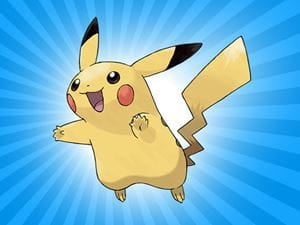
By now, you’ve noticed the hordes of people slowly shuffling through the streets, crowding around landmarks and churches and bus stops, their fingers mysteriously flicking their phones. Every now and again, there is a cry of “Charizard,” and the entire herd moves more quickly than you could have imagined, stampeding down the street and out of view.
No, there’s been no surprisingly placid zombie apocalypse. It’s just Pokémon Go!
Pokémon, pronounced “POH-kay-MON,” is an incredibly popular game and media franchise created by Satoshi Tajiriin 1995. Tajiri drew inspiration from his childhood hobby, insect collecting, to develop a game in which players captured, trained, and traded a wide variety of fantastical creatures whose myriad designs were inspired by insects, old Japanese shows, and anime.
Playing the many Pokémon games involves two simple concepts—catch em’ all and win. Within the fictional Pokémon world, Pokémon are captured by players, who then teach them fighting moves and train them for battle. The more battles a Pokémon wins, the stronger it becomes, eventually undergoing a metamorphosis and evolving into a more powerful form. Players create teams of their best Pokémon, using them to battle other fictional Trainers within the game, as well as other real players through multiplayer play.
A Pokémon is caught by weakening it through a Pokémon battle, and then throwing a Poké Ball at it, which captures it, adding the creature to the player’s collection and creating an entry in their Pokédex —a device which records and displays detailed information about each Pokémon as it is captured.
Players venture through the Pokémon world, defeating well-established computer-controlled Trainers called Gym Leaders, who are especially powerful. When a player defeats a Gym Leader, they are given a Gym Badge. Any Trainer who earns eight Gym Badges is eligible to face the Elite Four—the most powerful Trainers—and go on to win the Pokémon League Championships.
To compare Pokémon to sports, the player is the coach of a relatively unknown football team that has to learn the rules, train, and overcome nearly impossible odds to defeat all the big teams and win the Super Bowl. Pokémon, with its roots in the 1990s, is an extremely fond memory for many people, even those who haven’t kept up with the game’s many sequels throughout the years. The word Pokémon brings to mind the feelings of camaraderie that came from trading and battling with friends, and excitedly talking about the latest catch or unexpected evolution—it’s the same feeling someone might get from seeing their favorite childhood band playing once again after a long hiatus.
And that’s a large part of why Pokémon Go has been such an overwhelming success. Not only do we now have access to Pokémon on our phones, but we get to live that childhood dream of actually going out into the world to look for Pokémon. It’s like not only seeing that favorite band again, but having the opportunity to meet its members.
Pokémon Go is a mobile game in every sense of the word. When players open the game, a map of their local area appears, fed by real GPS data which tracks their position. Upon this map are places called PokeStops—usually landmarks, restaurants, churches, and other notable places—that players can visit to gather Poké Ball and other consumable in-game items.
These stops are where many players congregate. In-game devices called Lures can be attached to a PokeStop, which draw in more Pokémon to be captured, which, in turn, draws more players. This is why certain places which feature several PokeStops clustered together—such as a museum or mall—are drawing such crowds of players.
In Pokémon Go, Pokémon appear on the players’ maps, and must be tapped with a finger in order to be engaged in battle. Unlike previous generations of Pokémon games, the player does not use their own Pokémon to weaken a wild Pokémon. To capture the creature, a player simply flicks a Poké Ball with their finger, throwing the ball at the Pokémon. If the ball strikes just right, the creature is caught. There are several strategies involved in this—it’s not a simple throw. You can learn tips in gameplay guides if you wish to play.
Although may Pokémon Go players are adults, there is also a sizable portion of children wandering around outside looking for Pokémon, and so many parents may be concerned, not wholly understanding what their children are actually participating in. With the basic information out of the way, let’s take a look at a few of those concerns, and what you might want to talk to your kids about before they put on their Trainer hat and backpack and leave for the Pokémon Championships.
Situational awareness is essential when playing Pokémon Go. Because the game takes players outside, and often further and further away from home in search of PokeStops with which to refill their easily-depleted Poké Ball collections, children can become lost, or wander into dangerous areas or situations. Encourage your child to be aware of their surroundings, to look up from their phones often, and to stay out of streets. If needed, establish geographic boundaries that your child should not cross. Set them up to have a great time by making sure they’re aware enough of their surroundings to not injure themselves. That takes care of the physical danger.
There are many parents who are concerned about the game’s psychological dangers, as well, however. At first glance, Pokémon may seem violent, or could seem to desensitize players to animal harm. However, Pokémon is actually designed to be much less violent than other games.
The designer, Tajiri, purposefully designed Pokémon battles to end with the losing Pokémon fainting rather than dying, and thought it unhealthy to equate the concept of death with losing in a video game. He felt that many of the video games of 1995 were too violent, and so wanted to give players something else, something different that harkened back to his own innocent bug-catching days. Within the Pokémon universe, Pokémon do not suffer for their Trainers, and they do not die. They willingly obey players, becoming their friends, in a way, and fighting for them much the same as a sports team “fights” for its coach. In the contemporary world of video games, there are few games with a better heart. In terms of violence, Pokémon can be deemed psychologically safe.
But what of spiritual concerns? There have been articles floating about the internet for years decrying Pokémon as satanic, and these articles have exploded in popularity right along with Pokémon Go. These stories, often involving the creator of Pokémon, Tajiri, speaking about his hatred for Christianity, and how that inspired his creation, are utterly false. Tajiri said no such thing, and drew his inspiration, as we’ve seen, from his childhood bug-catching experiences.
Some may be concerned with the concept of evolution in Pokémon games, but this isn’t evolution as it is in our real world—it’s the metamorphosis of a Pokémon into a stronger form once it reaches a certain level. This is simply how the Pokémon world works, much as our own laws of physics and biology govern our real world. For example, in reality, a chicken hatches from an egg. In the fictional Pokémon world, that same chicken might evolve from a chick at level 10—it’s how things work there, and makes no comment on how things should work in the actual world. The Pokémon games advocate no particular scientific or theological views, and are quite safe in that regard.
Finally, there’s some consternation about older players joining in the fun. To return to the sports analogy, it’s really no different from playing a game of football or baseball—it’s just another avenue toward the enjoyment of life. We often feel the need to relegate certain activities into the mutually exclusive baskets of “adulthood,” and “childhood.” But ask yourself—who is the arbitrator of such things? And are such designations useful? Perhaps these labels could be replaced with “good for life,” and “bad for life,” instead. And anything that gets us exploring cultural landmarks, exercising, and socializing, and especially anything that simply puts a smile on the faces of so many cannot be bad.
Pokémon Go has become a worldwide sensation, bringing in new players and veterans, and the young, and the old, all united in their mission to catch em’ all. As long as you have a talk with your kids, reminding them to remain aware of our surroundings and to leave PokeStops as clean—or cleaner—than they found them, all will be well, and fun will ensue. The game brings people together in a way few games have ever done before, and your children will likely return with the names of a few new friends. And why not go out and join them, occasionally? One of the best ways of getting to know your children is exploring what they love. You might just find yourself hooked, as well, sneaking out of the house late at night to catch that Ghastly that just appeared across the street.
So if you see your kids wandering around outside, flicking their finger across the touchscreen of their phone and occasionally raising a fist to the air in triumph, don’t worry. They just want to be the very best, like no one ever was.

